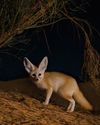NOW YOU SEE ME...
BBC Wildlife
|August 2021
Some animals use colour change to blend into the background; for others it is a powerful form of communication. But how exactly do they do it?

Years ago, during a field trip to the Scottish island of Cumbrae, I came face to face with a stout bobtail squid. As I watched, rapt, the tiny mollusc blushed from ghostly pale to deep red and back again, like a magic performance. But this was no illusion.
Squid are part of a whole spectrum of species that are able to change colour – an ability that comes with several speed settings. At its more relaxed end there is a handful of birds and mammals – including the Arctic fox, willow ptarmigan and snowshoe hare – that undergo a seasonal whitening triggered by waning day length. The transformation occurs as pigment disappears from fur and feathers. In mammal fur, this makes space for more air, which provides the added bonus of extra insulation as temperatures plummet.
Other environmental factors, such as ultraviolet, diet and surroundings, can also trigger gradual colour changes, involving alterations to the type and concentration of pigments within skin, exoskeleton, feathers or fur. A diet-driven transition is performed by several species of crab spiders, which ambush flower-visiting insects. The arachnids take about a week to morph from white to yellow, hiding in plain sight against their preferred backdrop of golden blooms.
For crustaceans, a slow colour change allows them to adapt to alterations in their environment. Chameleon prawns, for instance, transition between green and red, tracking the seasonal appearance of seaweed in their rocky shore habitat; shore crabs take on a more uniform colour as they mature, allowing them to blend in as they migrate onto the seabed of the subtidal zone.
Denne historien er fra August 2021-utgaven av BBC Wildlife.
Abonner på Magzter GOLD for å få tilgang til tusenvis av kuraterte premiumhistorier og over 9000 magasiner og aviser.
Allerede abonnent? Logg på
FLERE HISTORIER FRA BBC Wildlife

BBC Wildlife
"I was terrified the elephant would ram us"
African elephant in Kenya
2 mins
January 2026

BBC Wildlife
ALL YOU EVER NEEDED TO KNOW ABOUT THE Fennec fox
THE FENNEC FOX IS THE SMALLEST fox in the world, with a body length that can be as little as 24cm.
3 mins
January 2026

BBC Wildlife
INTO THE PLASTISPHERE
A unique synthetic ecosystem is evolving in our oceans – welcome to the plastisphere
7 mins
January 2026

BBC Wildlife
“More than half of all animal life exists in a parasitic relationship, and all life lives in symbiosis”
Our survival depends on species evolving to live together - but some relationships take dark turns
7 mins
January 2026

BBC Wildlife
Are animals able to dream?
SLEEP IS A MYSTERIOUS THING. FOR A long time, we weren't sure why we do it.
1 mins
January 2026

BBC Wildlife
Does a cuckoo know it's a cuckoo?
ABSURD LITTLE BIRDS ACROSS THE world lay their eggs in the nests of other species, leaving the hapless parents to raise a changeling at the expense of their own offspring.
2 mins
January 2026

BBC Wildlife
Orcas killing young sharks
Juvenile great whites are easy prey for orca pod
1 mins
January 2026

BBC Wildlife
Ocean goes on tour
Acclaimed film touring the UK, backed by live orchestra and choir
1 min
January 2026

BBC Wildlife
Feisty bats hunt like lions
Winged mammals use a 'hang and wait' strategy to take down large prey
1 mins
January 2026

BBC Wildlife
SNAP-CHAT
Richard Birchett on magical merlins, wily coyotes and charging deer
2 mins
January 2026
Translate
Change font size

